| George Herbert Walker Bush | |
 | |
| In office January 20, 1989 – January 20, 1993 | |
| Vice President | Dan Quayle |
| Preceded by | Ronald Reagan |
| Succeeded by | Bill Clinton |
| In office January 20, 1981 – January 20, 1989 Acting President on July 13, 1985 | |
| President | Ronald Reagan |
| Preceded by | Walter Mondale |
| Succeeded by | Dan Quayle |
| In office January 30, 1976 – January 20, 1977 | |
| President | Gerald Ford |
| Preceded by | William E. Colby |
| Succeeded by | Adm. Stansfield Turner |
10th[1] United States Ambassador to the United Nations
| |
| In office 1971–1973 | |
| President | Richard Nixon |
| Preceded by | Charles W. Yost |
| Succeeded by | John A. Scali |
Member of the United States House of Representatives from Texas's 7th congressional district
| |
| In office January 3, 1967 – January 3, 1971 | |
| Preceded by | John V. Dowdy |
| Succeeded by | Bill Archer |
| Born | June 12 1924 Milton |
| Political party | Republican |
| Spouse(s) | Barbara Pierce Bush |
| Alma mater | Yale University |
| Occupation | Businessman (Oil) |
| Religion | Episcopalian |
| Signature | |
George Herbert Walker Bush (born June 12, 1924), sometimes known as Bush 41,[2] was the forty-first President of the United States, serving from 1989 to 1993. Before his presidency, Bush was the forty-third Vice President of the United States in the administration of Ronald Reagan. He has also served as the member of the United States House of Representatives for the 7th district of Texas (1967–1971), the United States Ambassador to the United Nations (1971–1973), Chairman of the Republican National Committee (1973–1974), Chief of the United States Liaison Office in the People's Republic of China (1974–1976), and Director of Central Intelligence (1976–1977).
Bush is the son of Prescott Bush, who served in the United States Senate from 1953 to 1963, and Dorothy Walker Bush. He is the father of George W. Bush, the 43rd and current President of the United States, and Jeb Bush, former Governor of Florida.
Upon the death of Gerald Ford in 2006, Bush became the oldest living United States president.
Early years[]
George Herbert Walker Bush was born at 173 Adams Street in Milton[3] on June 12, 1924. The Victorian house where he was born is privately owned and not open to the public. The Bush family moved from Milton to Greenwich shortly after his birth.
George began his formal education at the Greenwich Country Day School in Greenwich. Beginning in 1936, Bush attended Phillips Academy[4] in Andover, where he held a large number of leadership positions including being the president of the senior class and secretary of the student council, president of the community fund-raising group, the Society of Inquiry, a member of the editorial board of the school newspaper, the Philippian, captain of both the varsity baseball and soccer teams.[5] It is said that he was a member of A.U.V., or "Auctoritas, Unitas, Veritas" (Latin for "Authority, Unity, Truth"), an exclusive fraternity.
World War II[]
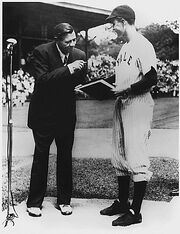
George Bush met Babe Ruth as a student at Yale
After graduating from Phillips Academy in June 1942, he joined the U.S. Navy on his 18th birthday to become an aviator. After completing the 10-month course, he was commissioned as an ensign in the U.S. Naval Reserve at Corpus Christi on June 9, 1943, just three days before his 19th birthday, which made him the youngest naval aviator to that date.
After finishing flight training, he was assigned to Torpedo Squadron (VT-51) as photographic officer in September 1943. As part of Air Group 51, his squadron was based on the USS San Jacinto (CVL-30) in the spring of 1944. San Jacinto was part of Task Force 58 that participated in operations against Marcus and Wake Islands in May, and then in the Marianas during June. On June 19, the task force triumphed in one of the largest air battles of the war. Shortly after takeoff Bush's aircraft made a forced water landing. A destroyer rescued the young pilot and his crew, although the plane was lost. On July 25, Bush and another pilot received credit for sinking a small cargo ship off Palau.[6][7]

George Bush in his TBM Avenger on the carrier USS San Jacinto in 1944
After Bush's promotion to Lieutenant Junior Grade on August 1, the San Jacinto commenced operations against the Japanese in the Bonin Islands. On September 2, 1944, Bush piloted one of four Grumman TBM Avenger aircraft from VT-51 that attacked the Japanese installations on Chichi Jima. For this mission his crew included Radioman Second Class John Delaney and Lieutenant Junior Grade William White, who substituted for Bush's regular gunner. During their attack, four Avengers from VT-51 encountered intense antiaircraft fire. While starting the attack, Bush's aircraft was hit and his engine caught on fire. Despite the fact that his plane was on fire, he completed his attack and released the bombs over his target, scoring several damaging hits. With his engine on fire, Bush flew several miles from the island, where he and one other crew member on the TBM Avenger bailed out of the aircraft. However, the other man's parachute did not open, and he fell to his death. It was never determined which man bailed out with Bush. Both Delaney and White were killed in action. While Bush waited four hours in his inflated raft, several fighters circled protectively overhead until he was rescued by the lifeguard submarine USS Finback. For this action Bush received the Distinguished Flying Cross. During the month he remained on the USS Finback, Bush participated in the rescue of other pilots.
Bush subsequently returned to San Jacinto in November 1944 and participated in operations in the Philippines. When San Jacinto returned to Guam, the squadron, which had suffered 50% casualties of its pilots, was replaced and sent to the United States. Through 1944, he had flown 58 combat missions for which he received the Distinguished Flying Cross, three Air Medals, and the Presidential Unit Citation awarded aboard the San Jacinto.
Because of his valuable combat experience, Bush was reassigned to Norfolk Navy Base and put in a training wing for new torpedo pilots. He was later assigned as a naval aviator in a new torpedo squadron, VT-153. With the surrender of Japan, he was honorably discharged in September 1945 and then entered Yale University.
Marriage, Yale, and Skull and Bones[]
Almost immediately upon his return from the war in December 1944, George Bush married Barbara Pierce. Their marriage produced six children: George Walker Bush, Pauline Robinson Bush ("Robin," 1949–1953, died of leukemia), John Ellis "Jeb" Bush, Neil Mallon Bush, Marvin Bush, and Dorothy Bush Koch.
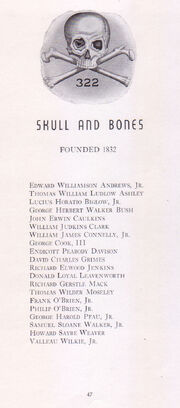
Skull and Bones entry from the 1948 Yale Banner; George Herbert Walker Bush is listed fourth down
While at Yale, he joined the Delta Kappa Epsilon fraternity and was elected president. He also captained the Yale baseball team, and as a left-handed first baseman, played in the first College World Series. Late in his junior year he was, like his father Prescott Bush (1917), tapped for membership by the Skull and Bones secret society. Some people believe that through this organization, also known as "the Order", Bush made connections with other influential people and families which would shape his career.
Bush graduated Phi Beta Kappa from Yale in 1948 with a B.S. in economics.[8]
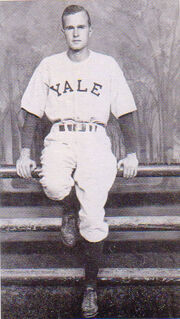
Captain-elect "Poppy" Bush as featured in a 1948 Yale Banner
Business ventures[]
After graduating from Yale, Bush went into the Texas oil exploration business. He was given a position with Dresser Industries, a subsidiary of Brown Brothers Harriman, where his father served on the board of directors for 22 years. His son, Neil Mallon Bush, is named after his employer at Dresser, Henry Neil Mallon, who was a close family friend dating back to Skull & Bones at Yale in 1918 along with Prescott. Zapata Corporation was created by Bush and the Liedtke brothers in 1953 as Zapata Oil.
Campaigns for Senate and Congress[]
In 1964, Bush won the Republican Party's nomination for the U.S. Senate from Texas. His opponent was the incumbent Democratic Senator Ralph Yarborough. Yarborough made several personal attacks against Bush, calling him a "tool of the eastern kingmakers" and a right-wing extremist. Bush lost the general election.
Bush did not give up on elective politics and was elected in 1966 to the United States House of Representatives from the 7th District of Texas, defeating Democrat Frank Briscoe with 57% of the vote. Despite being a first-term congressman, Bush was appointed to the powerful House Ways and Means Committee.[9]
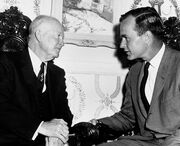
Bush with President Dwight D. Eisenhower
In 1970, President Nixon convinced Bush to relinquish his House seat to again run for the Senate against Democratic Senator Ralph Yarborough, a fierce Nixon critic. In the Republican primary, Bush easily defeated conservative Robert Morris, a defeated 1964 candidate, by a margin of 87.6% to 12.4%. However, former Congressman Lloyd Bentsen, a native of Mission, defeated Yarborough in the Democratic primary, 816,641 votes (53%) to 724,122 (47%). Yarborough then endorsed Bentsen. With Yarborough defeated in the primary, Nixon's support for Bush's campaign waned.
Because there was no presidential election in 1970, turnout in Texas was unusually low in the general election. Bentsen defeated Bush by a margin similar to that in his primary victory over Yarborough. Ironically, Bentsen later became the Democratic Party nominee for Vice President in the 1988 presidential election on a ticket with Massachusetts Governor Michael Dukakis and lost to Bush.
1970s[]
After the 1970 election loss, President Richard Nixon appointed Bush to United States Ambassador to the United Nations, at which he served from 1971 to 1973.
After Nixon was re-elected President in 1972, he asked Bush to become Chairman of the Republican National Committee. Bush held this position during the Watergate scandal, when the popularity of both Nixon and the Republican Party plummeted. Bush defended Nixon steadfastly, but later as Nixon's complicity became clear he focused more on defending the Republican Party while still maintaining loyalty to Nixon.
After Nixon's resignation in 1974, Vice President Gerald R. Ford became President, and Bush was one of the two leading contenders to be appointed vice president by Ford, but he lost to the other leading contender, Nelson Rockefeller. Bush had the support of many conservative elements in the Republican Party, particularly Barry Goldwater, against Rockefeller for the Vice Presidency. Ford appointed Bush to be Chief of the U.S. Liaison Office in the People's Republic of China. (Since the United States at the time maintained official relations with the Republic of China on Taiwan and not the People's Republic of China, the Liaison Office did not have the official status of an embassy and Bush did not formally hold the position of "ambassador" even though he unofficially acted as one.)
In 1976, Ford brought Bush back to Washington to become Director of Central Intelligence. Bush claimed the appointment was "a real shocker" and denied any prior involvement with the agency.
Interestingly, initially Bush's confirmation as Director of Central Intelligence was opposed by many pundits and politicians still reeling from the Watergate scandal (when Bush was head of the RNC, and a steadfast defender of Nixon) and the Church Committee investigating whether CIA-ordered foreign assassinations were being directed towards domestic officials, including President Kennedy. Many arguments against Bush's initial confirmation were that he was too partisan for the office. The Washington Post, George Will, and Senator Frank Church were some notable figures opposed to Bush's nomination. After a pledge by Bush not to run for either President or Vice President in 1976, opposition to his nomination died down.
Bush served in this role for 355 days, from January 30, 1976 to January 20, 1977.[10] The CIA had been rocked by a series of revelations, including revelations based on investigations by the Senate's Church Committee, about the CIA's illegal and unauthorized activities, and Bush was credited with helping to restore the agency's morale.[11] In his capacity as DCI, Bush gave national security briefings to Jimmy Carter both as a Presidential candidate and as President-elect, and discussed the possibility of remaining in that position in a Carter administration.[12]
After a Democratic administration took power in 1977, Bush became Chairman of the First International Bank in Houston. He also became an adjunct professor of Administrative Science at Rice University in the Jones School of Business in 1978, the year it opened. The course, Organization Theory, involved lectures from Bush regarding the organizations he headed—the Central Intelligence Agency, the National Republican Party, a U.S. congressional office, the USA Representative Office to China, and an oil exploration company. Just months before Bush hit the presidential campaign trail, he was also candid about his internal debate to enter the primaries.
He also became a board member of the Committee on the Present Danger.
1980 presidential campaign and Vice Presidency[]
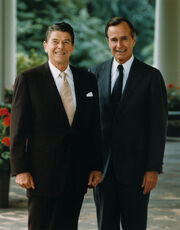
Bush with his former boss, Ronald Reagan
In the 1980 presidential election, Bush ran for the presidency, stressing his wide range of government experience. In the contest for the Republican Party nomination, despite Bush's establishment backing, the front-runner was Ronald Reagan, former actor and Governor of California who was running for his third presidential bid.
In the primary election, Bush represented the centrist wing in the GOP, whereas Reagan represented the conservative wing. He labeled Reagan's supply side-influenced plans for massive tax cuts "voodoo economics." During the election, Reagan once famously described Bush as a "Brooks Brothers Republican," in response to which Bush opened his jacket at a press conference, smiling, to reveal a J. Press logo. Bush won the Iowa caucus to start the primary season, then told the press that he had "Big Mo" (or momentum). However, Reagan came back to decisively win the New Hampshire primary, and Bush's "mo" subsided.[13] With a growing popularity among the Republican voting base, Reagan won most of the remaining primaries as well as the nomination.
After some preliminary discussion of choosing former President Gerald Ford as his running mate, Reagan selected Bush as his Vice Presidential nominee, placing him on the winning Republican presidential ticket of 1980.
Four years later, the Reagan-Bush ticket won again in a landslide in against the Democrats' Walter Mondale-Geraldine Ferraro ticket.
During his second term as Vice President, Bush became the first Vice President to become Acting President when, on July 13, 1985, President Reagan underwent surgery to remove polyps from his colon. Bush served as Acting President for approximately eight hours, most of which he passed playing tennis.
When the Iran-Contra Affair broke in 1986, Bush, like the president, stated that he had been "out of the loop" and unaware of the Iran initiatives related to arms trading.[14]
1988 presidential campaign[]

The 1988 presidential electoral votes by state
In 1988, after nearly eight years as Vice President, Bush again ran for President. His challengers for the Republican presidential nomination included U.S. Senator Bob Dole and Conservative Christian televangelist Pat Robertson.
Though considered the early frontrunner for the Republican nomination, Bush came in third in the Iowa caucus, beaten by winner Dole and runner-up Robertson. However, Bush rebounded to win the New Hampshire primary, perhaps partly because of television commercials portraying Dole as a tax raiser. Once the multiple-state primaries such as Super Tuesday began, Bush's organizational strength and fundraising lead were impossible for the other candidates to match, and the nomination was his.
Leading up to the 1988 Republican National Convention, there was much speculation as to Bush's choice of running mate. In a move anticipated by few and later criticized by many, Bush chose little-known U.S. Senator Dan Quayle of Indiana. On the eve of the convention, Bush trailed Democratic nominee Michael Dukakis, then Massachusetts governor, by double digits in most polls.

President-elect George Bush, the current President Ronald Reagan, and Soviet Premier Mikhail Gorbachev in New York City, 1988
Bush, often criticized for his lack of eloquence when compared to Reagan, surprised many by giving perhaps the best speech of his public career, widely known as the "Thousand points of light" speech[15] for his use of that phrase to describe his vision of American community. Bush's acceptance speech and a generally well-managed Convention catapulted him ahead of Dukakis in the polls, and he held the lead for the rest of the race. Bush's acceptance speech at the convention included the famous pledge, Read my lips: no new taxes.
The campaign was noted for its highly negative television advertisements. One advertisement run by the Bush campaign showed Dukakis awkwardly riding in a U.S. Army tank. Bush blamed Dukakis for polluting the Boston Harbor as the Massachusetts governor. Bush also pointed out that Dukakis was opposed to the law that would require all students to say the pledge of allegiance. Another, produced and placed by an independent group supporting Bush, referred to murderer Willie Horton, a man who had committed a rape and assault while on a weekend furlough from a life sentence being served in Massachusetts.
Dukakis's unconditional opposition to capital punishment also led to a pointed question during the U.S. presidential debates. Moderator Bernard Shaw asked Dukakis hypothetically if Dukakis would support the death penalty if his wife were raped and murdered. Dukakis's response appeared to many oddly wooden and technical, and contributed toward the characterization of him as "soft on crime." These images helped enhance Bush's stature as a possible Commander-in-Chief compared to the Massachusetts governor.
Bush beat Michael Dukakis and Lloyd Bentsen soundly in the Electoral College, by 426 to 111 (Bentsen received one vote). In the nationwide popular vote, Bush took 53.4% of the ballots cast while Dukakis gained 45.6%. Bush was the first serving Vice President to be elected President since Martin Van Buren in 1836.
Presidency 1989-1993[]

Chief Justice William Rehnquist administering the oath of office to Bush during Inaugural ceremonies at the United States Capitol, January 20, 1989.
Foreign policy[]
Foreign policy drove the Bush Presidency from its first days. In his January 20, 1989, Inaugural Address upon taking the Presidency, Bush said, "I come before you and assume the Presidency at a moment rich with promise. We live in a peaceful, prosperous time, but we can make it better. For a new breeze is blowing, and a world refreshed by freedom seems reborn; for in man's heart, if not in fact, the day of the dictator is over. The totalitarian era is passing, its old ideas blown away like leaves from an ancient, lifeless tree. A new breeze is blowing, and a nation refreshed by freedom stands ready to push on. There is new ground to be broken, and new action to be taken."[16]
Leading up to the first Gulf War, on September 11, 1990, President Bush addressing a joint session of Congress stated: "Out of these troubled times, our fifth objective — a New World Order — can emerge: a new era"[17]
With these words President Bush gave the order to start the military action which would later be known as the Gulf War.
Manuel Noriega[]
Operation Just Cause was the U.S. military invasion of Panama that deposed General Manuel Noriega in December 1989. Involving an expeditionary force of 25,000 troops and state-of-the-art military equipment, the invasion was the largest American military operation since the Vietnam War. General Manuel Noriega was at one time a U.S. ally, who was increasingly using Panama to facilitate the drug traffic from South America to the United States. In the 1980s, dictator Manuel Noriega was one of the most recognizable names in the United States, being constantly covered by the press. The deteriorating situation in Panama was a growing embarrassment for the Reagan Administration, which President Bush inherited. The military implementation took place under supervision of Joint Chiefs of Staff Chairman General Colin Powell who—as National Security Advisor for President Reagan—knew well the Panama situation and dictator Noriega. The invasion was preceded by massive protests in Panama against Noriega. Bush's Secretary of Defense Dick Cheney visited American troops in Panama right after the invasion. President Bush visited Panama with his wife in June 1992, to give support to the first post-invasion Panamanian government.
Gulf War[]

President Bush visited American troops in Saudi Arabia on Thanksgiving Day, 1990
As President, Bush is perhaps best known internationally for leading the United Nations coalition in the 1990–1991 Gulf War. In 1990, Iraq, led by Saddam Hussein invaded its oil-rich neighbor to the south, Kuwait. The broad coalition, in an operation known as Desert Shield, sought to remove Iraqi forces from Kuwait and ensure that Iraq did not invade Saudi Arabia. Bush summed up his position succinctly when he said, "This aggression will not stand," and, "This is not a war for oil. This is war against aggression." On November 29, the UN passed a resolution establishing a deadline that authorized the nations allied with Kuwait 'to use all necessary means' if Iraq did not withdraw from Kuwait by January 15, 1991. Fighting began on January 17, 1991, when U.S.-led air units launched a devastating series of air attacks against Iraq, with this operation referred to as Desert Storm.[18] On February 24, coalition ground troops attacked Iraq, and on February 26, Iraqi forces began retreating from Kuwait. Coalition troops pursued the retreating Iraqi troops into Iraq, to within 150 miles (240 km) of Baghdad before withdrawing. President Bush declared a cease-fire on February 27.
In a foreign policy move that would later be questioned, President Bush achieved his stated objectives of liberating Kuwait and forcing Iraqi withdrawal, then ordered a cessation of combat operations —allowing Saddam Hussein to stay in power. Bush later explained that he did not give the order to overthrow the Iraqi government because it would have "incurred incalculable human and political costs... We would have been forced to occupy Baghdad and, in effect, rule Iraq".[19][20]
Post-Soviet breakup[]
After the dissolution of the USSR in 1991, President Bush and Soviet President Mikhail Gorbachev declared a U.S.-Soviet strategic partnership at the summit that July, marking the end of the Cold War. President Bush declared that U.S.-Soviet cooperation during the Persian Gulf War in 1990–1991 had laid the groundwork for a partnership in resolving bilateral and world problems.
- Malta Summit[21]
- Arms control: START I, Nunn-Lugar Cooperative Threat Reduction
NAFTA[]

From left to right: (standing) President Carlos Salinas, President Bush, Prime Minister Brian Mulroney; (seated) Jaime Serra Puche, Carla Hills, and Michael Wilson at the NAFTA Initialing Ceremony, October 1992
Bush's government, along with the Progressive Conservative Canadian Prime Minister Brian Mulroney, spearheaded the negotiations of the North American Free Trade Agreement (NAFTA). Bush's primary negotiator was Trade Secretary Carla Anderson Hills. While initial signing was possible during his term, negotiations made slow but steady progress during Bush's term. President Clinton would go on to make the passage of NAFTA a priority for his administration, despite its conservative and Republican roots — with the addition of two side agreements — to achieve its passage in 1993.
Pardons[]
As other Presidents have done, Bush issued a series of pardons during his last days in office. On December 24, 1992, he pardoned six former government employees implicated in the Iran-Contra scandal - most prominently former Secretary of Defense Caspar Weinberger. Weinberger had been scheduled to stand trial on January 5, 1993, for lying to Congress regarding his knowledge of arms sales to Iran and concealing 1700 pages of his personal diary detailing discussions with other officials about the arms sales.
As Weinberger's private notes contained references to Bush's endorsement of the secret shipments to Iran, some believe that Bush's pardon was an effort to prevent an order for Bush to appear before a grand jury or possibly to avoid an indictment. Weinberger's indictment stated that Weinberger's notes contradicted Bush's assertions that he had only peripheral knowledge of the arms for hostages deal. Lawrence Walsh, the Independent Counsel assigned to the case, charged that "the Iran-contra cover-up, which has continued for more than six years, has now been completed." Walsh likened the pardons to President Richard Nixon's Saturday Night Massacre. Bush responded that the Walsh probe constituted an attempt to criminalize a policy dispute between the legislative and executive branches. In addition to Weinberger, Bush pardoned Duane R. Clarridge, Clair E. George, Robert C. McFarlane, Elliott Abrams, and Alan G. Fiers Jr., all of whom had been indicted and/or convicted of charges by the Independent Counsel. He is also known to have given executive clemency to Aslam P. Adam, a convicted heroin dealer. Additionally, Bush pardoned Orlando Bosch, a known anti-Castro terrorist who was linked to the bombing of Mackey Airlines in Fort Lauderdale, Florida, and had been previously convicted of firing a bazooka at a Polish freighter in Miami harbor.[22][23]
Administration and Cabinet[]
The official White House portrait of President George H.W Bush
| The Bush Cabinet | ||
|---|---|---|
| Office | Name | Term |
| President | George H. W. Bush | 1989–1993 |
| Vice President | J. Danforth Quayle | 1989–1993 |
| Secretary of State | James A. Baker III | 1989–1992 |
| Lawrence Eagleburger | 1992–1993 | |
| Secretary of Treasury | Nicholas F. Brady | 1989–1993 |
| Secretary of Defense | Richard B. Cheney | 1989–1993 |
| Attorney General | Richard L. Thornburgh | 1989–1991 |
| William P. Barr | 1991–1993 | |
| Secretary of the Interior | Manuel Lujan | 1989–1993 |
| Secretary of Agriculture | Clayton K. Yeutter | 1989–1991 |
| Edward Madigan | 1991–1993 | |
| Secretary of Commerce | Robert A. Mosbacher | 1989–1992 |
| Barbara Hackman Franklin | 1992–1993 | |
| Secretary of Labor | Elizabeth Hanford Dole | 1989–1990 |
| Lynn Martin | 1991–1993 | |
| Secretary of Health and Human Services |
Louis W. Sullivan | 1989–1993 |
| Secretary of Education | Lauro Cavazos | 1989–1990 |
| Lamar Alexander | 1991–1993 | |
| Secretary of Housing and Urban Development |
Jack F. Kemp | 1989–1993 |
| Secretary of Transportation | Samuel K. Skinner | 1989–1992 |
| Andrew H. Card | 1992–1993 | |
| Secretary of Energy | James D. Watkins | 1989–1993 |
| Secretary of Veterans Affairs | Edward J. Derwinski | 1989–1993 |
Supreme Court appointments[]
Bush appointed the following Justices to the Supreme Court of the United States:
- David Souter – 1990
- Clarence Thomas – 1991
1992 re-election campaign[]

The 1992 presidential electoral votes by state
The tail end of the late 1980s recession, that had plagued most of Bush's term in office, was a contributing factor to his defeat in the 1992 Presidential election to Governor Bill Clinton of Arkansas. The coalition victory in the Persian Gulf War led to a feeling that Bush's re-election was almost assured, but the economic recession coupled with a perceived failure to end the war properly reduced his popularity. Bush was also perceived as being "out of touch" with the American worker. One incident that was said to lend credence to this suspicion occurred during a technology trade show in which Bush appeared "amazed" upon seeing a demonstration of a supermarket scanner. However, Andrew Rosenthal, the reporter who broke the story was not present during the demonstration. He had relied on his own interpretation of a pool report by Gregg McDonald. The New York Times stood by its interpretation of the event, but Newsweek and Mark Duffy of Time Magazine, as well as the man who demonstrated the product for Bush, all took issue with Rosenthal's characterization.[24] Nevertheless, media outlets reported the story as it tied in with and supported the notion that the president was out of touch with the common man.
Several other factors were key in his defeat, including agreeing in 1990 to raise taxes despite his famous "Read my lips: no new taxes" pledge not to institute any new taxes. In doing so, Bush alienated many members of his conservative base, losing their support for his re-election. Bush raised taxes in an attempt to address an ever-increasing budget deficit, which some attributed to the Reagan tax cuts and military spending of the 1980s. George Bush had been supported in 1988 by conservatives to continue the Reagan revolution, and was seen as a failure in this regard. Ironically, Bush had previously admonished Reagan's supply side tax cuts in the 1980 presidential primary when he referred to Reagan's tax proposals as "voodoo economics."
Ross Perot won 19% of the popular vote, the highest total for a third-party candidate since Theodore Roosevelt on the ticket of the Bull-Moose Party. In early 1992 a Gallup poll found the President's approval rating to be at an all-time low, 29%. Despite his defeat, George H. W. Bush left office in 1993 with a 56% job approval rating.[25]

Presidents (from left) George H.W. Bush, Ronald Reagan, Jimmy Carter, Gerald Ford, and Richard Nixon at the dedication of the Ronald Reagan Presidential Library in 1991.
Post-Presidency[]
Since his 1992 election campaign, Bush has retired to be with his wife at their home in the exclusive neighborhood of Tanglewood in Houston, with a presidential office nearby. They summer at Walker's Point in Kennebunkport, Maine. Bush holds his own fishing tournament in Islamorada, an island in the Florida Keys.
Since 1992, Bush has made many public appearances, and even more so in the eight years of his son's Presidential term. He and Mrs. Bush attended the state funeral of Ronald Reagan in June 2004, and of Gerald Ford in January 2007. One month later, he was awarded the Ronald Reagan Freedom Award in Beverly Hills by former First Lady Nancy Reagan.
In 1993, Bush was awarded an honorary knighthood (GCB) by Queen Elizabeth II. [26]
Bush was also present in various ceremonies during the construction of USS George H. W. Bush, which is the last Nimitz class supercarrier of the United States Navy, and one of the few that are named after persons that are living at the time of the vessel's christening.
Quotes[]
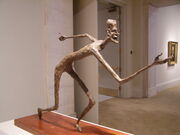
Pat Oliphant's sculpture in the US National Portrait Gallery of George H.W. Bush throwing horseshoes.
- "This aggression will not stand."
- "Read my lips: No new taxes."
- "If you don't feel something strongly you're not going to achieve."
- "Americans should be more like The Waltons and less like The Simpsons."
- "After a deluded gunman assassinated President Kennedy, our nation turned to Gerald Ford and a select handful of others to make sense of that madness. And the conspiracy theorists can say what they will, but the Warren Commission report will always have the final definitive say on this tragic matter. Why? Because Jerry Ford put his name on it and Jerry Ford’s word was always good." Eulogy for Gerald R. Ford, January 2, 2007
Texas A&M University[]
Texas A&M University is home to both the George Bush Presidential Library and the George Bush School of Government and Public Service.[27] This tenth presidential library was built between 1995 and 1997 and contains the presidential and vice-presidential papers of George H.W. Bush and the vice-presidential papers of Dan Quayle.[28] The school, offers a master's degree in public policy and one in international affairs as well as two research degrees, officially launched in 1997. It became a separate school within the university in 1999.[27]
Presidential Library[]
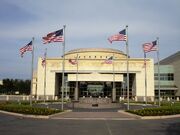
The George Bush Presidential Library entrance
The George Bush Presidential Library and Museum is the presidential library named for Bush. It was dedicated on November 6, 1997 and opened to the public shortly thereafter. It was designed by the architectural firm of Hellmuth.
The George Bush Presidential Library and Museum is located on a ninety-acre site on the west campus of Texas A&M University in College Station, Texas. The Library and Museum is situated on a plaza adjoining the Presidential Conference Center and the Texas A&M Academic Center. It operates under the administration of the NARA under the provisions of the Presidential Libraries Act of 1955.
George Bush School of Government and Public Service[]
The George Bush School of Government and Public Service is a graduate public policy school at Texas A&M University in College Station. It is named for former President George H.W. Bush. The Bush School is part of the George Bush Presidential Library complex. The graduate school offers four programs: two master's degree programs (Public Service Administration and International Affairs) and two certificate programs (Advanced International Affairs and Homeland Security). The Masters Program in International Affairs (MPIA) program offers a choice of concentration on either National Security Affairs or International Economics and Development. The MPIA program requires the graduate students to pass a foreign language exam in order to graduate. In addition, the school offers both certificate programs online. Texas A&M has begun planning and faculty collaboration that would expand the current Certificate in Homeland Security Program into a Master of Science in Homeland Security Program,[29] coordinated by the Integrative Center for Homeland Security, recognized as a national leader in the emerging field of homeland security strategy and policy. Dr. Robert M. Gates, Secretary of Defense and former Director of Central Intelligence, was the school's first dean before becoming president of the university.
Books[]
Note: All The Best is not a memoir and Bush has declared that he will not be writing one.
- A World Transformed 1998 ISBN 0-679-43248-5
- All The Best, George Bush: My Life and Other Writings 1999 ISBN 068483958X
- Heartbeat: George Bush in His Own Words: George Bush in His Own Words (compiled by Jim McGrath) 2003 ISBN 0806524979
See also[]
- Bush family
- Church Committee
- October surprise conspiracy
- Iran hostage crisis
- George W. Bush, son of George H. W. Bush
Footnotes[]
- ^ US ambassadors to the UN
- ^ Bush 41 Defends Son To Arab Critics, CBS News
- ^ "Presidential Avenue: George Bush". http://www.presidentialavenue.com/gb.cfm.
- ^ "Kennedy, the Adamses and One More in Boston". 2006-09-15. http://travel.nytimes.com/2006/09/15/travel/escapes/15trip.html.
- ^ "Former President George Bush honored at 60th reunion". 2002-06-08. http://www.andover.edu/news/bush.htm.
- ^ "Lieutenant Junior Grade George Bush, USNR". 2001-04-06. http://www.history.navy.mil/faqs/faq10-1.htm.
- ^ Duane Hove, American Warriors: Five Presidents in the Pacific Theater of World War II, Burd Street Press, 2003. ISBN 1-57249-307-0.
- ^ "George Herbert Walker Bush — Infoplease.com". 2007. http://www.infoplease.com/ipa/A0760625.html.
- ^ " "Chapter 10.1: Rubbers Goes to Congress (part 1)". 1991. http://www.modernhistoryproject.org/mhp/ArticleDisplay.php?Article=BushCh10-1".
- ^ The George Bush Center for Intelligence - CIA, accessed February 26, 2006
- ^ George Herbert Walker Bush - WorldRoots.com, accessed February 26, 2006
- ^ "CIA Briefings of Presidential Candidates; Chapter 5: In-Depth Discussions With Carter". Central Intelligence Agency: Center for the Study of Intelligence. https://www.cia.gov/library/center-for-the-study-of-intelligence/csi-publications/books-and-monographs/cia-briefings-of-presidential-candidates/cia-8.htm. Retrieved 2007-10-11.
- ^ Expectations, momentum, fatal mistakes - Tom Curry, MSNBC, January 15, 2004
- ^ Transcript - New York Times, June 30, 1997
- ^ George H. W. Bush: 1988 Republican National Convention Acceptance Address - transcript, speech delivered August 18, 1988, Superdome
- ^ George H. W. Bush: Inaugural Address - transcript, speech delivered January 20, 1989
- ^ George H. W. Bush: Address Before a Joint Session of the Congress on the Persian Gulf Crisis and the Federal Budget Deficit - transcript, speech delivered September 11, 1990
- ^ After the Storm, Anthony H. Cordesman
- ^ Reasons Not to Invade Iraq, by George Bush Sr. - The Memory Hole, accessed February 26, 2006
- ^ A World Transformed - accessed February 26, 2006
- ^ Transcripts from Malta Summit - CNN
- ^ "U.S. promotes double standard in how it deals with 'terrorist' cases". 2005-05-09. http://www.usatoday.com/news/opinion/columnist/wickham/2005-05-09-wickham_x.htm.
- ^ "Venezuelans Absolve Bosch in Bombing of Plane". 1980-09-24. http://www.latinamericanstudies.org/belligerence/bosch-absolved.htm.
- ^ "Maybe I'm Amazed". 2001-04-01. http://www.snopes.com/history/american/bushscan.htm.
- ^ Poll: Clinton Legacy Mixed - Gary Langer, ABC News, January 17, 2001
- ^ The Times, 1 December 1993, p24
- ^ a b "The Bush School of Government and Public Service: History". Texas A&M University. 2005. http://bush.tamu.edu/about%5Fus/history/. Retrieved 2007-03-22.
- ^ "The Birth of the Tenth Presidential Library: The Bush Presidential Materials Project, 1993–1994". George Bush Presidential Library. http://bushlibrary.tamu.edu/giq.html. Retrieved 2007-03-22.
- ^ Master of Science in Homeland Security Program notes
Further reading[]
- Barilleaux, Ryan J.; Stuckey, Mary E. (1992). Leadership and the Bush Presidency: Prudence or Drift in an Era of Change. New York: Praeger. ISBN 0-275-94418-2.
- Bush, George H. W. (1999). All the best, George Bush: my life in letters and other writings. New York: Scribner. ISBN 0-684-83958-X.
- Bush, George H. W.; Scowcroft, Brent (1998). A World Transformed. New York: Knopf. ISBN 0-679-43248-5.
- Ducat, Stephen J. (2004). The wimp factor: gender gaps, holy wars, and the politics of anxious masculinity. Boston: Beacon Press. ISBN 0-8070-4344-3.
- Duffy, Michael; Goodgame, Dan (1992). Marching in place : the status quo Presidency of George Bush. New York: Simon & Schuster. ISBN 0-671-73720-1.
- Green, John Robert (2000). The Presidency of George Bush. Lawrence: University Press of Kansas. ISBN 0-7006-0993-8.
- Hyams, Joe (1991). Flight of the Avenger: George Bush at War. San Diego: Harcourt Brace Jovanovic. ISBN 0-15-131469-1.
- Kelley, Kitty (2004). The Family: The True Story of the Bush Dynasty. London: Doubleday. ISBN 0-385-50324-5.
- Podhoretz, John (1993). Hell of a Ride: Backstage at the White House Follies, 1989-1993. New York: Simon & Schuster. ISBN 0-671-79648-8.
- Smith, Jean Edward (1992). George Bush's War. New York: Henry Holt & Company. ISBN 0-8050-1388-1.
- Tarpley, Webster G.; Chaitkin, Anton (1991). George Bush: The Unauthorized Biography. Washington: Executive Intelligence Review. ISBN 0-943235-05-7.
External links[]
| Find more about George H. W. Bush on Wikipedia's sister projects: |
| Definitions from Wiktionary | |
| Textbooks from Wikibooks | |
| Quotations from Wikiquote | |
| Source texts from Wikisource | |
| Images and media from Commons | |
| News stories from Wikinews | |
| Learning resources from Wikiversity |
- Bush Presidential Library and Museum
- White House biography
- Works by George Bush at Project Gutenberg Note: Contains only Bush's 1990 State of the Union address
- George Herbert Walker Bush (1924-2018)/biography at the Biographical Directory of the United States Congress
- Essays on Bush and His Administration
- George H. W. Bush Speeches
| |||||||||||||||||||||||||
| |||||||
| |||||
| |||||||
| |||||||||
| |||||
| ||||||||||||||||||||||||||||||||||||||||||||||||||||||||||
| Persondata | |
|---|---|
| NAME | Bush, George Herbert Walker |
| ALTERNATIVE NAMES | Bush, George Sr. |
| SHORT DESCRIPTION | 41st president of the United States (1989-1993) |
| DATE OF BIRTH | 12 June 1924 |
| PLACE OF BIRTH | Milton |
| DATE OF DEATH | |
| PLACE OF DEATH | |
| This page uses content from the English language Wikipedia. The original content was at George H. W. Bush. The list of authors can be seen in the page history. As with this Familypedia wiki, the content of Wikipedia is available under the Creative Commons License. |



